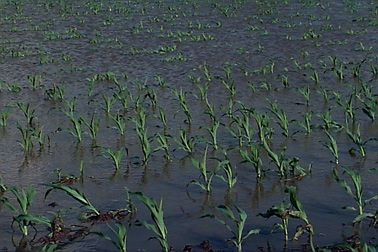 |
Damage to Corn From Flooding or PondingR.L. (Bob) NielsenAgronomy Department , Purdue University West Lafayette, IN 47907-1150 Internet address: rnielsen@purdue.edu In addition to some isolated hail damage from recent "popup" thunderstorms, isolated instances of very intensive rainfall (otherwise known as "toad stranglers) resulted in flooding or ponding of corn fields. Prior to the 6-leaf stage (measured by visible leaf collars) or when the growing point is near or below the soil surface, corn can survive only two to four days of flooded conditions. The oxygen supply in the soil is depleted after about 48 hours in a flooded soil. Without oxygen, the plant cannot perform critical life sustaining functions; e.g. nutrient and water uptake is impaired, root growth is inhibited, etc. If temperatures are warm during flooding (greater than 77F) plants may not survive 24 hours. Cooler temperatures prolong survival. Once the growing point is above the water level the likelihood for survival improves greatly. Even if flooding doesn't kill plants outright it may have a long term negative impact on crop performance. Excess moisture during the early vegetative stages retards corn root development. As a result, plants may be subject to greater injury during a dry summer because root systems are not sufficiently developed to access available subsoil water. Flooding and ponding can also result in losses of nitrogen through denitrification and leaching. If flooding in corn is less than 48 hours, crop injury should be limited. To confirm plant survival, check the color of the growing point (it should be white and cream colored, while a darkening or softening usually precedes plant death) and look for new leaf growth three to five days after water drains from the field. Certain disease problems which may become greater risks due to flooding and cool temperatures are corn smut and crazy top. The fungus that causes crazy top depends on saturated soil conditions to infect corn seedlings. There is limited hybrid resistance to these diseases and predicting damage is difficult until later in the growing season. |